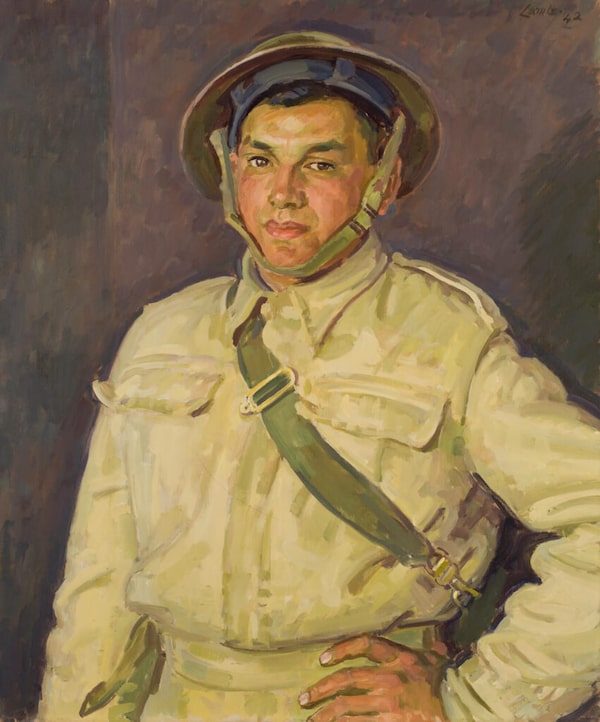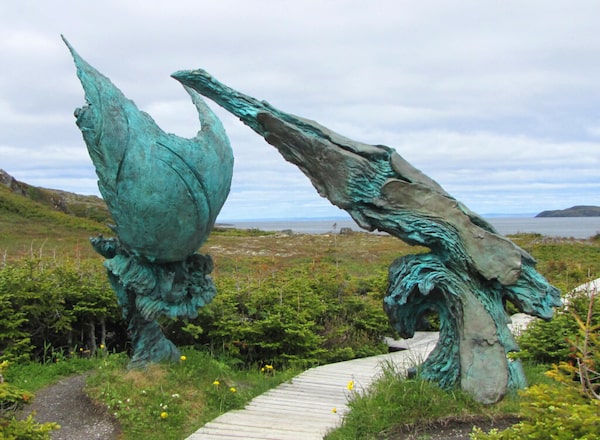
A 1942 portrait by Henry Lamb was originally titled A Redskin in the Royal Canadian Artillery. In 1999, the soldier was identified by Laura Brandon and the title of the portrait was changed to Trooper Lloyd George Moore, RCA.Courtesy of Canadian War Museum
Certain paintings probably come to mind when you think of Canadian war art. Benjamin West’s 1770 oil on canvas, The Death of General Wolfe. Works from the First World War done by future Group of Seven members: A.Y. Jackson’s A Copse, Evening and Frederick Varley’s For What?, both from 1918.
If anyone has a grasp on the history of Canadian war art, it is Laura Brandon, author of War Art in Canada: A Critical History. Brandon was the historian, art and war, at the Canadian War Museum from 1992 until 2015. Around the time she started working on this book, the Truth and Reconciliation Commission report was delivered, and she knew she needed to rethink the project.
“I realized that if I was going to write a book about Canadian war art in its wholeness, I had to go as far back in history as I possibly could. Because Canadian war art doesn’t begin in the postcontact period,” said Brandon, stressing that while she is entirely of settler ancestry, she felt it was crucial that she include Indigenous history and representation.
“It became of compelling importance that I try to put this bigger story on the map.”

Frederick Varley, For What?, 1918, oil on canvas.Courtesy of Canadian War Museum
War Art in Canada – a free online publication produced by the Art Canada Institute that is available beginning Remembrance Day – is a survey, an overview, an introduction. It is not meant to be exhaustive or even comprehensive, but it is a revelation, nonetheless.
“Art, like history, tends to favour the victorious, so, until recently, the bulk of Canadian war art has reflected Western traditions and genres at the expense of Indigenous expressions,” Brandon writes in the preface. “This book attempts to redress the balance.”
Rather than the obvious starting point – perhaps that Death of General Wolfe painting – the narrative begins thousands of years before contact.
“We have in Canada a long, long history of conflict, whether we want to acknowledge it or not,” said Brandon during an interview this week from Ottawa, where she lives.
Early Indigenous artifacts that were related to conflict – weapons or clothing, for instance – have often not been studied as fine art, but ethnographically. And they have not featured significantly in Canada’s military art history. This publication changes that. One of its earliest pieces is a 17th-century calumet, or ceremonial pipe. Smoking the calumet cemented military alliances and peace treaties.
“From the beginning, Indigenous peoples fought back,” Brandon writes. Even before the French and British arrived, the Vikings sent expeditions here. This history is addressed in an evocative 2002 sculpture Meeting of Two Worlds, by Luben Boykov and Richard Brixel, installed in Newfoundland. The sculpture represents the meeting between the Vikings and Indigenous people more than 1,000 years ago.

Luben Boykov and Richard Brixel, Meeting of Two Worlds, unveiled July 5, 2002, L’Anse aux Meadows, N.L.Courtesy of Historic Sites Association of Newfoundland and Labrador, St. John’s.
One of the featured pieces with the longest history is Box with Quilled Battle Scene by Mesaquab (Jonathan Yorke). While the work was made in 1904, it depicts a battle scene originally painted on a rock at Ontario’s Lake Couchiching about 200 years earlier. Mesaquab, who was Ojibway, used porcupine quills and sweetgrass to reproduce the scene from memory onto the lid of a birchbark box. (In War Art in Canada, Indigenous names are used first, with anglicized names in parentheses afterward.)
Another event addressed in art was a delegation of four Indigenous leaders – three Haudenosaunee and one Anishinaabe – who travelled to London in 1710 with British military leaders and met with Queen Anne. She commissioned portraits of them by Dutch artist John Verelst. This portrait series is known as the Four Kings.
Frederick Alexcee’s A Fight Between the Haida and the Tsimshian, c. 1896, depicts an 1855 battle between the Indigenous nations at what was then called Port Simpson, and is now Lax Kw’alaams, B.C. Alexcee, the son of a Tsimshian woman and a Haudenosaunee man, paints a large colonial structure looming in the background. The structure is in the light; the Indigenous warriors in its shadow.

John Verelst, Sa Ga Yeath Qua Pieth Tow, King of the Maquas, 1710.Courtesy of Library and Archives Canada
Canada has a rich history of art depicting war. But even in more recent, 20th-century history, there is an absence of Indigenous figures in official Canadian war art, despite several programs that have employed artists to create images from the battlefield. During the First World War, the 4,000 members of the Canadian Expeditionary Force who were of Indigenous descent were virtually ignored in imagery, Brandon writes.
As were the 3000 Indigenous people in Canada who enlisted during the Second World War. Even when there was some attention paid, the portrayals – or titles – could be offensive. For instance, a 1942 portrait by Henry Lamb was originally titled A Redskin in the Royal Canadian Artillery. In 1999, the soldier was identified – by Brandon herself – and the title of the portrait was changed to Trooper Lloyd George Moore, RCA.
A significant number of Indigenous artists have now participated in the Canadian Forces Artists Program. They include Adrian Stimson, a visual and performance artist who is a member of the Siksika Nation in Southern Alberta.

A.Y. Jackson, A Copse, Evening, 1918.Courtesy of Canadian War Museum
The book’s final image is Cree artist Kent Monkman’s monumental 2018 painting Miss Chief’s Wet Dream. Monkman employs the visual language of Western history painting to denounce the actual history, as he cleverly inserts Indigenous characters and concerns.
Brandon hopes that this publication is a starting point for others – especially Indigenous art historians. “I hope somebody will pick it up and keep going,” she said. “Keep on exploring, keep on learning, keep on seeking understanding, keep on seeking meaning and never underestimate visual culture in all its forms as a mean of telling our history.”
Editor’s note: An earlier version of this article included an incorrect first name for Adrian Stimson.
Sign up for The Globe’s arts and lifestyle newsletters for more news, columns and advice in your inbox.
 Marsha Lederman
Marsha Lederman